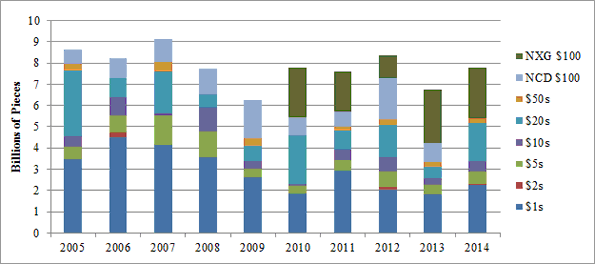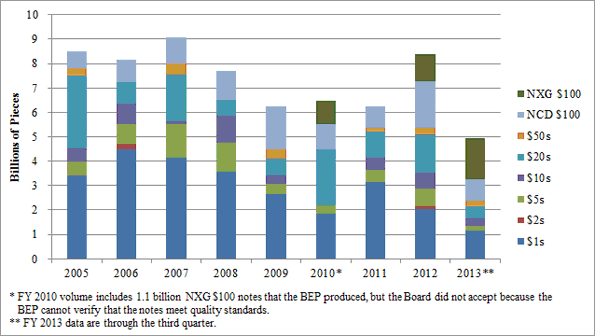2014 Federal Reserve Note Print Order
The Board of Governors (the Board), as the issuing authority for Federal Reserve notes, approved and submitted its fiscal year (FY) 2014 order for 7.8 billion Federal Reserve notes, valued at $297.1 billion, to the U.S. Treasury Department’s Bureau of Engraving and Printing (BEP) on July 18, 2013.1 On July 22, 2014, the Board approved a revision to its FY 2014 order. Additional information regarding this revision may be found here.
The 7.8 billion notes included in the FY 2014 order reflect the Board’s estimate of net demand for currency from domestic and international customers. The print order is determined, by denomination, based on historical payments to and receipts from circulation, destruction rates, and also to build inventories of new-design notes before issuance. Historically, most of the notes that the Board orders each year replace unfit currency that Reserve Banks receive from circulation.2 The estimated number of notes that Reserve Banks will destroy accounts for nearly 90 percent of the proposed FY 2014 print order (excluding the quantity of new-design $100 notes). The expected growth of Reserve Bank payments to circulation accounts for the remainder of notes in the FY 2014 print order. The table below reflects the denominational breakdown of the Board’s FY 2014 order.3
| Denomination | Number of Notesa (000s of pieces) |
Dollar Value (000s of dollars) |
|---|---|---|
| $1 | 2,278,400 | $2,278,400 |
| $2 | 44,800 | $89,600 |
| $5 | 563,200 | $2,816,000 |
| $10 | 486,400 | $4,864,000 |
| $20 | 1,785,600 | $35,712,000 |
| $50 | 220,800 | $11,040,000 |
| $100 | 2,403,200 | $240,320,000 |
| Total | 7,782,400 | $297,120,000 |
a. The FY 2014 order includes a small quantity of currency of most denominations that the BEP has requested to make available for sale in the BEP Store;® and to meet special requests from the Secretary of the Treasury. Return to table.
The Board's FY 2014 order is about 3 percent higher than the average order we placed with the BEP between FY 2011 and FY 2013. The number of $1, $2, $5, $10, and $50 notes included in our order is largely unchanged from the average order. Demand and destruction rates for these denominations have been stable since 2011, and we do not estimate any significant changes for 2014. The number of $20 notes in our order is 79 percent greater than the average order because of increased domestic and international demand in 2013 that we expect to continue into 2014. The number of $100 notes included in our order is consistent with our planning for issuance of the new-design $100 note in October.
Appendix
Chart 1
Fiscal Year Print Orders
Chart 2
Notes Produced by the BEP
(by Fiscal Year)
Footnotes
1. The BEP operates on a fiscal year that begins on October 1 and ends on September 30. The Board submits its annual order for Federal Reserve notes at least 60 days before the beginning of the BEP’s fiscal year. Return to text.
2. Unfit notes are notes received in deposits from depository institutions that are destroyed because they do not meet the Federal Reserve’s quality criteria for recirculation. Return to text.
3. Charts 1 and 2 in the appendix show the Federal Reserve’s print orders between FY 2005 and FY 2014 and the number of notes produced by the BEP and delivered to the Board to meet those orders. Return to text.

